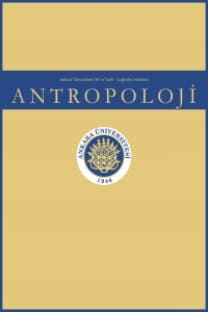Yoncatepe toplumunda Calcaneus ve Talus kemiklerinden cinsiyet ve boy tahmini
Arkeolojik kazı alanlarında bulunan insan iskeletleri o toplumun gelişim ve değişim süreçlerini anlamamıza yardımcı olmaktadır. Çalışmanın amacı, Yoncatepe toplumuna ait calcaneus ve talus kemikleri kullanılarak bireylerin cinsiyet ve boylarının tahmin edilmesi, ayrıca bireylerin vücut yapısı ve sağlık durumu hakkında bilgi sahibi olmaktır. Van-Yoncatepe’de 1998-1999 kazı döneminde yapılan çalışmalar sonucunda Erken Demir Çağına ait 6 adet oda mezar ortaya çıkarılmıştır. Yetişkinlere ait 56 adet calcaneus ve 64 adet talus kemiği dijital kumpas kullanılarak ölçülmüştür (mak. calcaneus uz.,mak. talus yük.). Cinsiyeti bilinmeyen Yoncatepe toplumunun ortalama boy uzunluğu calcaneus kemiğinden 161.16 ve talus kemiğinden 161.34 olarak hesaplanmıştır. Cinsiyet, kemiklerin ölçümlerinden çıkan ortalama değere göre tahmin edilmiştir. Buna göre, calcaneustan 30 adet erkek, 26 adet kadın, talustan 30 adet erkek 34 adet kadın birey olduğu tahmin edilmiştir. Sonuç olarak, Yoncatepe populasyonunun boy ve cinsiyeti, aynı veya yakın dönem diğer toplumlarla uyum göstermiştir
Anahtar Kelimeler:
Yoncatepe, boy tahmini, cinsiyet tahmini
The Estimation of Sex and Height by The Calcaneus and Talus in Yoncatepe Population
Human skeletons found in archaeological sites can help us understand the process of development and change in the population. The purpose of this study is to estimate the sex and height of Yoncatepe Population by examining their calcaneus and talus, in addition, to find out information about the body and health condition of the individuals of this population. Human remians, which belong to Early Iron Age, were found in 6 tombs during the excavations between 1998 and 1999. Measurements were taken from 56 calcanei and 64 tali of adults by using digital caliper (max. Calcaneus L., max. Talus H.). The average height of Yoncatepe population, whose sex was unknown, was calculated as 161,16 cm by calcanei and as 161,34 cm by tali. Sex was estimated by the average measurement of bones. Accordingly, 30 male and 26 female were estimated by calcanei, 30 male and 34 female were estimated by tali. As a result, the sex and height of Yoncatepe Population are similar to those of different populations of the same and near periods
Keywords:
Yoncatepe, body height, sex estimation,
___
Altunçul, H. ve İşcan, M.Y. (2003). “DNA'dan Kimlik Tayini: Sorun ve Çözümleri”, İstanbul Baro Dergisi, 77(1):63-73.Asala, S.A. (2001) “Sex Determination From the Head the Femur of South African Whites and Blacks”, Forensic Science International, 117:15-22.
Belli, O. ve Kavaklı, E. (2000) “1999 Yılı Van - Yoncatepe Kalesi ve Nekropolü Kazısı”, Kazı Sonuçları Toplantısı, 22:369-384.
Çevik, N. (2000) Urartu Kaya Mezarları Ve Ölü Gömme Gelenekleri, Ankara: Türk Tarih Kurumu Yayınları.
Çilingiroğlu, A. (1988) “Van- Dilkaya Höyüğü Kazısı”, Kazı Sonuçları Toplantısı, 9(1):229-248.
Demirjian, A. Goldstein, H. Ve Tanner, J.M. (1973) “A New System of Dental Age Assessment”, Human Biology, 45,211-227.
Güleç, E. (1989) “Paleoantropolojik Verilere Göre Eski Anadolu Bireylerinin Boy Açısından İncelenmesi”, Arkeometri Sonuçları Toplantısı, 5:147-160.
Holland, T. (1995) “Brief Communication: Estimation of Adult Stature from Calcaneus and Talus”, American Journal of Physical Anthropology, 96:315-320.
Hunnargi, S.A. Menezes, R.G. Kanchan, T. Lobo, S.W. Binu, V.S., Uysal, S. Kumar, H.R.S. Baral, P. Herekar, N.G. ve Garg, R.K. (2008) “Sexual Dimorphism of the Human Sternum in a Maharashtrian Population of India: A Morphometric analysis”, Legal Medicine, 10(1).
İşcan, M.Y. (1985) “Osteometric Analysis of Sexual Dimorphism in the Sternal End of the Rib”, Journal of Forensic Science, 30(4):1090-1099.
İşcan, M.Y. (1985) “Osteometric Analysis of Sexual Dimorphism in the Sternal End of the rib”, Journal of Forensic Sciences, 30(4):1090-1099.
İşcan, M.Y. (1988) “Rise of Forensic Anthropology”, Yearbook of Physical Anthropology, 31:203-30.
İşcan, M.Y. ve Konyar, E. (2005) “Adli Arkeoloji: Olay Yerine Arkeolojik Yaklaşım”, Arkeoloji ve Sanat, 120(27):89-100.
Krogman, W M. ve İşcan, M Y. (1986) The Human Skeleton in Forensic Medicine. Springfield, IL: Charles C. Thomas.
Marino, E.A. (1997) “A Pilot Study Using the First Cervical Vertebra as an Indicator of Race”, Journal of Forensic Science, 42 (6):1114-8.
Mergen, A. (2006). Erken Demir Çağında Cinsiyet ve Boy Gelişimi, Yüksek Lisans Tezi, İstanbul Üniversitesi, Adli Tıp Enstitüsü, Sosyal Bilimler Anabilim Dalı.
Musgrave, J.H. ve Harneja, N.K. (1978) “The Estimation of Adult Stature from Metacarpal Bone Length”, American Journal of Physical Anthropology, 48:113-120.
Özer, İ., Sevim, A., Pehlevan, C., Arman, O., Gözlük, P. ve Güleç, E. (1999) “Karagündüz Kazısından Çıkarılan İskeletlerin Paleoantropolojik Analizi”, Arkeometri Sonuçları Toplantısı, 14:75-96.
Patriquin, M.L. Steyn, M. ve Loth, S.R. (2002) “Metric Assessment of Race From the Pelvis in South Africans”, Forensic Science International, 127(1-2):104-113.
Ryan, I. ve Bidmos, M.A. (2007) “Skeletal Height Reconstruction From Measurements of the Skull in the Indigenous Sounth Africans”, Forensic Science International,167(1):16-21.
Sevim, A. Pehlevan, C. Açıkkol, A. Yılmaz, H. ve Güleç, E. (2001) “Karagündüz Erken Demir Çağı İskeletleri”, Arkeometri Sonuçları Toplantısı, 17:37-48.
Steyn, M. İşcan, M.Y. (2008) “Metric Sex Determination From the Pelvis in Modern Greeks”, Forensic Science International, 179 (1):86.
Steyn, M. ve İşcan, M Y. (1998) “Sexual Dimorphism in the Crania and Mandibles of South African Whites”, Forensic Science International,98,111-119.
Steyn. M. ve İşcan, M.Y. (1999) “Osteometric Variation in the Humerus: Sexual Dimorphism in South Africans”, Forensic Science International, 106: 77-85.
Washburn, S. (1948) “Sex Differences in the Pubic Bone”, American Journal of Physical Anthropology, 6(2),199-208.
Yiğitpaşa, D. (2010) “Urartu Ölü Gömme Gelenekleri ve Ölümle İlgili Ritüeller”, Güzel Sanatlar Enstitüsü Dergisi, 25:177-203.
- ISSN: 0378-2891
- Yayın Aralığı: Yılda 2 Sayı
- Başlangıç: 1963
- Yayıncı: Ankara Üniversitesi Basımevi
Sayıdaki Diğer Makaleler
Yener BEKTAŞ, Timur GÜLTEKİN, Galip AKIN, Sibel ÖNAL
Adli Antropolojik İncelemelerde "Bütünsel Yaklaşım": Multidisipliner Bir Çalışma
Üremeye Dair Yaygın Söylemler: Ortadoğu Bağlamında Türkiye’yi Yeniden Değerlendirmek
Yoncatepe toplumunda Calcaneus ve Talus kemiklerinden cinsiyet ve boy tahmini
Adli Antropolojik İncelemelerde "Bütünsel Yaklaşım": Multidisipliner Bir Çalışma
Alevilikte Kadın Erkek Eşitliği Söylemine Eleştirel Bir Yaklaşım
Herakleia Perinthos (Marmara Ereğlisi) Toplumunda Erken Sutur Kaynaşması
